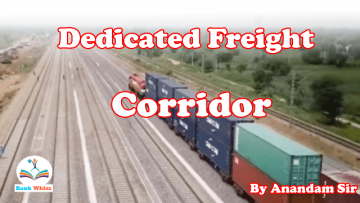
Introduction
A Dedicated Freight Corridor (DFC) is a network of railway lines dedicated to the movement of freight trains. The network of such railway lines is quite different from that of the passenger railway lines as the freight railway lines require higher voltage, stronger rail tracks for heavy loads at a fair speed.
There are six freight corridors traversing the entire country with the purpose of a safe and efficient freight transportation system. Out of six, the four were approved in January 2018 while the two are being implemented. The rail tracks under DFCs (also called ‘Golden Quadrilateral Freight Corridor) connect four metropolitans – Delhi, Mumbai, Chennai and Kolkata. Two diagonals are also there under DFCs viz. North South Dedicated Freight Corridor (Delhi to Chennai) and East-West Dedicated Freight Corridor (Kolkata to Mumbai). Two freight corridors namely ‘Eastern Dedicated Freight Corridor’ and ‘Western Dedicated Freight Corridor’ are under implementation. ‘Dedicated Freight Corridor Corporation of India’ undertakes planning, development and mobilsation of financial resources and construction, maintenance and operation of such rail tracks.
Importance of DFCs
India is one of the largest railway networks in the world earning a large chunk of revenue for the government and thus contributing considerably to GDP growth. The following are to be addressed properly to present itself in the league of developed countries:
(A) The Indian railways have higher freight volumes but there is no substantial investment in infrastructure. Hence, these require substantial investment for spreading newer and stronger tracks. DFCs make it easy.
(B) At present, the tracks of the freight trains and those of the passenger ones are the same. So, the tracks undergo heavy pressure of the movement of both kinds of trains, which brings about disruption in time schedule especially in the case of freight trains. Delayed running of such trains means delayed delivery, which affects the growth of the economy very badly. On the one hand, India envisages being a 5 trillion dollar economy by 2024, on the other hand, if the economy runs slow, it can never fulfill its dream. DFCs can enable India to move faster.
(C) At present, India is committed to reducing greenhouse emission gases. DFCs will enable the Indian railways to reduce such emissions by 64% by introducing electricity-run trains.
(D) DFCs promote the state-of-art technology that enables the Indian railways to regain its market share of freight transport by creating additional capacity and guaranteeing efficient, reliable, safe, and cheaper options for mobility.
(E) DFCs support the government’s initiatives towards ecological sustainability by encouraging users to adopt railways as the most environment-friendly mode for their transport.
(F) India is one of the fastest-growing economies and so it requires adequate additional capacity for running a large number of freight trains to meet the demand. In addition, it requires an increased speed of freight trains and reduced cost per ton of freight carried.
(G) The mobility of freight trains is badly affected as against that of passenger trains. They always run behind time schedules and sometimes, their routes are diverted and thus forcing them to be delayed further. This affects revenue very badly.
After addressing the challenges, the main objectives of DFCs are:
1. To create additional railway infrastructure to cater to the present booming demand.
2. To segregate and manage freight traffic efficiently keeping in view customer satisfaction.
3. To help freight trains to run at a definite time table with the guaranteed delivery schedule.
4. To give up to 100 km/h speed.To use the latest and cost-effective practices by using state-of-the-art technology optimally.


